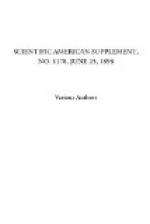In the extended litigation over the acid process patents, the points at issue related to the strength of the acid named in the various specifications and also to the methods of applying steam. Prof. Charles F. Chandler, called as an expert in one case, testified that the effects of acids, such as sulphuric or hydrochloric, upon rubber and rubber compounds, under varying strength and temperature, had been known at a period antedating all the patents then the basis of suits for infringement; also that their effect upon cotton and woolen fabrics had been equally well known. They had the same effect upon fibers, whether the latter were combined with rubber or not, but very strong acids would affect the rubber injuriously. The line of defense in this case was that “no invention was required in selecting the strength of acid; only the common sense of the manufacturer, aided by his skill and experience, was necessary to bring about the proper results.” In support of this a factory superintendent testified that varied stocks required skill and judgment in their treatment and more or less variation as to the strength of acid, temperature, etc.
As to the use of steam, Prof. Henry B. Cornwall, of Princeton College, called as an expert in another case, testified that, having put to a test the specifications in all the patents involved, he had found it necessary in no case to inject live steam into the mixtures of acid and rubber scrap in order to effect the decomposition and removal of either woolen or cotton fiber. The use of the acids specified was sufficient for this, and the various high temperatures called for were not essential for the destruction of the fibers. He neglected to mention, however, that the steam served an equally important purpose in devulcanizing the rubber.
It appeared that the practice in different factories had included the use of sulphuric acid varying from a 21/2 per cent. solution to the full commercial strength of the acid, but one of the defendant companies based their case upon their use of acid of the strength of 28 deg. to 30 deg. Baume, whereas the patent they were charged with infringing specified a strength of 66 deg.. Their tanks were lead-lined and provided on the interior with steam pipes running down the sides and along the bottom, the sections at the bottom being perforated and the steam admitted at a pressure of 75 to 80 pounds. The chemical treatment lasted from 21/2 to 4 hours.
The sulphuric acid treatment, however, is confined mainly to scrap containing cotton fiber. Where woolen fibers occur, which is much less frequently, their disintegration is accomplished generally by the use of caustic soda.




